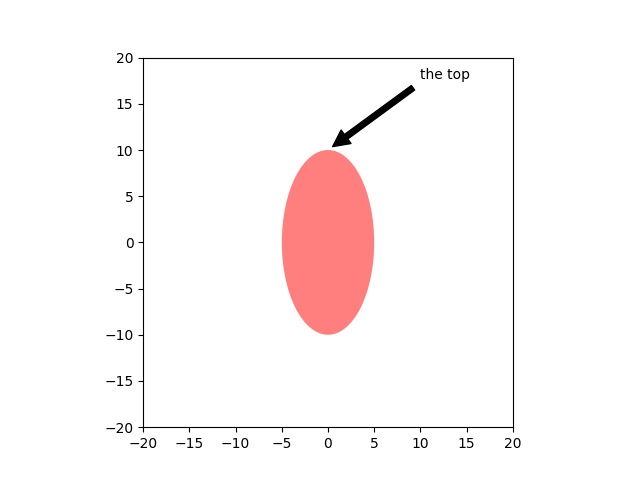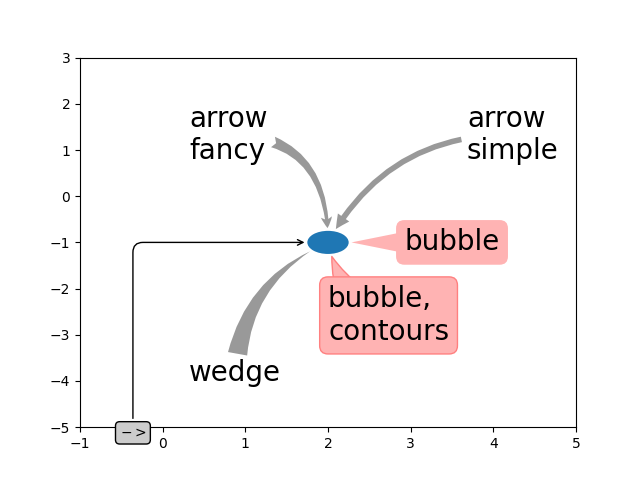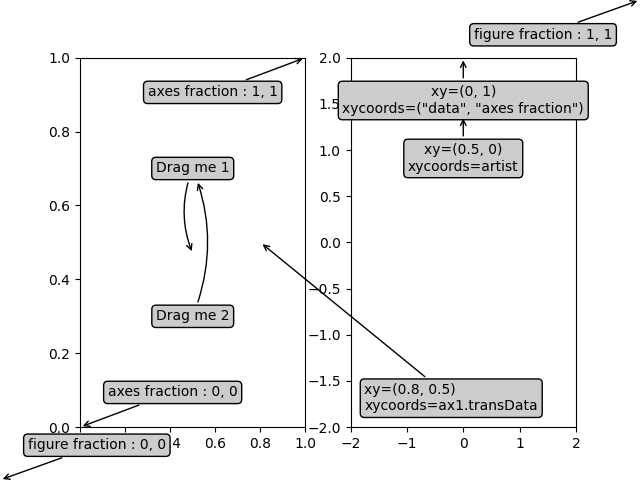注释图
以下示例显示了如何在matplotlib中注释绘图。这包括突出显示特定的兴趣点,并使用各种视觉工具来引起对这一点的关注。有关matplotlib中注释和文本工具的更完整和深入的描述,请参阅注释教程。
import matplotlib.pyplot as pltfrom matplotlib.patches import Ellipseimport numpy as npfrom matplotlib.text import OffsetFrom
指定文本点和注释点
您必须指定注释点 xy = (x, y) 来注释此点。另外,您可以为此注释的文本位置指定文本点 xytext=(x, y)。 (可选)您可以使用xycoords和textcoords的以下字符串之一指定xy和xytext的坐标系(默认为’data’):
'figure points' : points from the lower left corner of the figure'figure pixels' : pixels from the lower left corner of the figure'figure fraction' : 0,0 is lower left of figure and 1,1 is upper, right'axes points' : points from lower left corner of axes'axes pixels' : pixels from lower left corner of axes'axes fraction' : 0,0 is lower left of axes and 1,1 is upper right'offset points' : Specify an offset (in points) from the xy value'offset pixels' : Specify an offset (in pixels) from the xy value'data' : use the axes data coordinate system
注意:对于物理坐标系(点或像素),原点是图形或轴的(底部,左侧)。
(可选)您可以通过提供箭头属性字典来指定箭头属性,该属性可以从文本绘制和箭头到注释点
有效关键点是:
width : the width of the arrow in pointsfrac : the fraction of the arrow length occupied by the headheadwidth : the width of the base of the arrow head in pointsshrink : move the tip and base some percent away from theannotated point and textany key for matplotlib.patches.polygon (e.g., facecolor)
# Create our figure and data we'll use for plottingfig, ax = plt.subplots(figsize=(3, 3))t = np.arange(0.0, 5.0, 0.01)s = np.cos(2*np.pi*t)# Plot a line and add some simple annotationsline, = ax.plot(t, s)ax.annotate('figure pixels',xy=(10, 10), xycoords='figure pixels')ax.annotate('figure points',xy=(80, 80), xycoords='figure points')ax.annotate('figure fraction',xy=(.025, .975), xycoords='figure fraction',horizontalalignment='left', verticalalignment='top',fontsize=20)# The following examples show off how these arrows are drawn.ax.annotate('point offset from data',xy=(2, 1), xycoords='data',xytext=(-15, 25), textcoords='offset points',arrowprops=dict(facecolor='black', shrink=0.05),horizontalalignment='right', verticalalignment='bottom')ax.annotate('axes fraction',xy=(3, 1), xycoords='data',xytext=(0.8, 0.95), textcoords='axes fraction',arrowprops=dict(facecolor='black', shrink=0.05),horizontalalignment='right', verticalalignment='top')# You may also use negative points or pixels to specify from (right, top).# E.g., (-10, 10) is 10 points to the left of the right side of the axes and 10# points above the bottomax.annotate('pixel offset from axes fraction',xy=(1, 0), xycoords='axes fraction',xytext=(-20, 20), textcoords='offset pixels',horizontalalignment='right',verticalalignment='bottom')ax.set(xlim=(-1, 5), ylim=(-3, 5))

使用多个坐标系和轴类型
您可以在不同位置和坐标系中指定xypoint和xytext,也可以选择打开连接线并使用标记标记点。 注释也适用于极轴。
在下面的示例中,xy点是本机坐标(xycoords默认为’data’)。对于极轴,这是在(θ,半径)空间中。示例中的文本放在小数字坐标系中。文本关键字args如水平和垂直对齐被尊重。
fig, ax = plt.subplots(subplot_kw=dict(projection='polar'), figsize=(3, 3))r = np.arange(0, 1, 0.001)theta = 2*2*np.pi*rline, = ax.plot(theta, r)ind = 800thisr, thistheta = r[ind], theta[ind]ax.plot([thistheta], [thisr], 'o')ax.annotate('a polar annotation',xy=(thistheta, thisr), # theta, radiusxytext=(0.05, 0.05), # fraction, fractiontextcoords='figure fraction',arrowprops=dict(facecolor='black', shrink=0.05),horizontalalignment='left',verticalalignment='bottom')# You can also use polar notation on a cartesian axes. Here the native# coordinate system ('data') is cartesian, so you need to specify the# xycoords and textcoords as 'polar' if you want to use (theta, radius).el = Ellipse((0, 0), 10, 20, facecolor='r', alpha=0.5)fig, ax = plt.subplots(subplot_kw=dict(aspect='equal'))ax.add_artist(el)el.set_clip_box(ax.bbox)ax.annotate('the top',xy=(np.pi/2., 10.), # theta, radiusxytext=(np.pi/3, 20.), # theta, radiusxycoords='polar',textcoords='polar',arrowprops=dict(facecolor='black', shrink=0.05),horizontalalignment='left',verticalalignment='bottom',clip_on=True) # clip to the axes bounding boxax.set(xlim=[-20, 20], ylim=[-20, 20])


自定义箭头和气泡样式
xytext和注释点之间的箭头以及覆盖注释文本的气泡可高度自定义。 下面是一些参数选项以及它们的结果输出。
fig, ax = plt.subplots(figsize=(8, 5))t = np.arange(0.0, 5.0, 0.01)s = np.cos(2*np.pi*t)line, = ax.plot(t, s, lw=3)ax.annotate('straight',xy=(0, 1), xycoords='data',xytext=(-50, 30), textcoords='offset points',arrowprops=dict(arrowstyle="->"))ax.annotate('arc3,\nrad 0.2',xy=(0.5, -1), xycoords='data',xytext=(-80, -60), textcoords='offset points',arrowprops=dict(arrowstyle="->",connectionstyle="arc3,rad=.2"))ax.annotate('arc,\nangle 50',xy=(1., 1), xycoords='data',xytext=(-90, 50), textcoords='offset points',arrowprops=dict(arrowstyle="->",connectionstyle="arc,angleA=0,armA=50,rad=10"))ax.annotate('arc,\narms',xy=(1.5, -1), xycoords='data',xytext=(-80, -60), textcoords='offset points',arrowprops=dict(arrowstyle="->",connectionstyle="arc,angleA=0,armA=40,angleB=-90,armB=30,rad=7"))ax.annotate('angle,\nangle 90',xy=(2., 1), xycoords='data',xytext=(-70, 30), textcoords='offset points',arrowprops=dict(arrowstyle="->",connectionstyle="angle,angleA=0,angleB=90,rad=10"))ax.annotate('angle3,\nangle -90',xy=(2.5, -1), xycoords='data',xytext=(-80, -60), textcoords='offset points',arrowprops=dict(arrowstyle="->",connectionstyle="angle3,angleA=0,angleB=-90"))ax.annotate('angle,\nround',xy=(3., 1), xycoords='data',xytext=(-60, 30), textcoords='offset points',bbox=dict(boxstyle="round", fc="0.8"),arrowprops=dict(arrowstyle="->",connectionstyle="angle,angleA=0,angleB=90,rad=10"))ax.annotate('angle,\nround4',xy=(3.5, -1), xycoords='data',xytext=(-70, -80), textcoords='offset points',size=20,bbox=dict(boxstyle="round4,pad=.5", fc="0.8"),arrowprops=dict(arrowstyle="->",connectionstyle="angle,angleA=0,angleB=-90,rad=10"))ax.annotate('angle,\nshrink',xy=(4., 1), xycoords='data',xytext=(-60, 30), textcoords='offset points',bbox=dict(boxstyle="round", fc="0.8"),arrowprops=dict(arrowstyle="->",shrinkA=0, shrinkB=10,connectionstyle="angle,angleA=0,angleB=90,rad=10"))# You can pass an empty string to get only annotation arrows renderedann = ax.annotate('', xy=(4., 1.), xycoords='data',xytext=(4.5, -1), textcoords='data',arrowprops=dict(arrowstyle="<->",connectionstyle="bar",ec="k",shrinkA=5, shrinkB=5))ax.set(xlim=(-1, 5), ylim=(-4, 3))# We'll create another figure so that it doesn't get too clutteredfig, ax = plt.subplots()el = Ellipse((2, -1), 0.5, 0.5)ax.add_patch(el)ax.annotate('$->$',xy=(2., -1), xycoords='data',xytext=(-150, -140), textcoords='offset points',bbox=dict(boxstyle="round", fc="0.8"),arrowprops=dict(arrowstyle="->",patchB=el,connectionstyle="angle,angleA=90,angleB=0,rad=10"))ax.annotate('arrow\nfancy',xy=(2., -1), xycoords='data',xytext=(-100, 60), textcoords='offset points',size=20,# bbox=dict(boxstyle="round", fc="0.8"),arrowprops=dict(arrowstyle="fancy",fc="0.6", ec="none",patchB=el,connectionstyle="angle3,angleA=0,angleB=-90"))ax.annotate('arrow\nsimple',xy=(2., -1), xycoords='data',xytext=(100, 60), textcoords='offset points',size=20,# bbox=dict(boxstyle="round", fc="0.8"),arrowprops=dict(arrowstyle="simple",fc="0.6", ec="none",patchB=el,connectionstyle="arc3,rad=0.3"))ax.annotate('wedge',xy=(2., -1), xycoords='data',xytext=(-100, -100), textcoords='offset points',size=20,# bbox=dict(boxstyle="round", fc="0.8"),arrowprops=dict(arrowstyle="wedge,tail_width=0.7",fc="0.6", ec="none",patchB=el,connectionstyle="arc3,rad=-0.3"))ann = ax.annotate('bubble,\ncontours',xy=(2., -1), xycoords='data',xytext=(0, -70), textcoords='offset points',size=20,bbox=dict(boxstyle="round",fc=(1.0, 0.7, 0.7),ec=(1., .5, .5)),arrowprops=dict(arrowstyle="wedge,tail_width=1.",fc=(1.0, 0.7, 0.7), ec=(1., .5, .5),patchA=None,patchB=el,relpos=(0.2, 0.8),connectionstyle="arc3,rad=-0.1"))ann = ax.annotate('bubble',xy=(2., -1), xycoords='data',xytext=(55, 0), textcoords='offset points',size=20, va="center",bbox=dict(boxstyle="round", fc=(1.0, 0.7, 0.7), ec="none"),arrowprops=dict(arrowstyle="wedge,tail_width=1.",fc=(1.0, 0.7, 0.7), ec="none",patchA=None,patchB=el,relpos=(0.2, 0.5)))ax.set(xlim=(-1, 5), ylim=(-5, 3))


更多坐标系的例子
下面我们将展示几个坐标系的例子,以及如何指定注释的位置。
fig, (ax1, ax2) = plt.subplots(1, 2)bbox_args = dict(boxstyle="round", fc="0.8")arrow_args = dict(arrowstyle="->")# Here we'll demonstrate the extents of the coordinate system and how# we place annotating text.ax1.annotate('figure fraction : 0, 0', xy=(0, 0), xycoords='figure fraction',xytext=(20, 20), textcoords='offset points',ha="left", va="bottom",bbox=bbox_args,arrowprops=arrow_args)ax1.annotate('figure fraction : 1, 1', xy=(1, 1), xycoords='figure fraction',xytext=(-20, -20), textcoords='offset points',ha="right", va="top",bbox=bbox_args,arrowprops=arrow_args)ax1.annotate('axes fraction : 0, 0', xy=(0, 0), xycoords='axes fraction',xytext=(20, 20), textcoords='offset points',ha="left", va="bottom",bbox=bbox_args,arrowprops=arrow_args)ax1.annotate('axes fraction : 1, 1', xy=(1, 1), xycoords='axes fraction',xytext=(-20, -20), textcoords='offset points',ha="right", va="top",bbox=bbox_args,arrowprops=arrow_args)# It is also possible to generate draggable annotationsan1 = ax1.annotate('Drag me 1', xy=(.5, .7), xycoords='data',#xytext=(.5, .7), textcoords='data',ha="center", va="center",bbox=bbox_args,#arrowprops=arrow_args)an2 = ax1.annotate('Drag me 2', xy=(.5, .5), xycoords=an1,xytext=(.5, .3), textcoords='axes fraction',ha="center", va="center",bbox=bbox_args,arrowprops=dict(patchB=an1.get_bbox_patch(),connectionstyle="arc3,rad=0.2",**arrow_args))an1.draggable()an2.draggable()an3 = ax1.annotate('', xy=(.5, .5), xycoords=an2,xytext=(.5, .5), textcoords=an1,ha="center", va="center",bbox=bbox_args,arrowprops=dict(patchA=an1.get_bbox_patch(),patchB=an2.get_bbox_patch(),connectionstyle="arc3,rad=0.2",**arrow_args))# Finally we'll show off some more complex annotation and placementtext = ax2.annotate('xy=(0, 1)\nxycoords=("data", "axes fraction")',xy=(0, 1), xycoords=("data", 'axes fraction'),xytext=(0, -20), textcoords='offset points',ha="center", va="top",bbox=bbox_args,arrowprops=arrow_args)ax2.annotate('xy=(0.5, 0)\nxycoords=artist',xy=(0.5, 0.), xycoords=text,xytext=(0, -20), textcoords='offset points',ha="center", va="top",bbox=bbox_args,arrowprops=arrow_args)ax2.annotate('xy=(0.8, 0.5)\nxycoords=ax1.transData',xy=(0.8, 0.5), xycoords=ax1.transData,xytext=(10, 10),textcoords=OffsetFrom(ax2.bbox, (0, 0), "points"),ha="left", va="bottom",bbox=bbox_args,arrowprops=arrow_args)ax2.set(xlim=[-2, 2], ylim=[-2, 2])plt.show()


